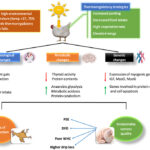Taxonomic Keys: A taxonomic key is a tool used by scientists to identify organisms based on a series of choices that lead to the correct name of a given item. Keys are structured as a step-by-step process where at each step, you select between two or more contrasting options. Helps in the identification and classification of organisms.
Different Kinds of Taxonomic Keys
1. Dichotomous Key: The most common and widely used key. At each step, the user is given two contrasting choices (di = two). Each choice leads to another pair of choices until the organism is identified.
Example:
a) Leaves needle-like → Go to step 2
b) Leaves broad → Go to step 3
Merits: Simple and easy to use. Efficient for beginners.
Demerits: Limited flexibility — if the specimen doesn’t fit the exact description, identification becomes difficult.
2. Polyclave Key (Multiple-Access Key): Instead of a strict sequence, the user can choose any character at any time. Often computer-based or presented in tables.
Example: You can start with color, size, habitat, or any observable trait.
Merits: Very flexible; you can start with the features you are sure about. Suitable for complex groups with lots of variation.
Demerits: Requires more information or technical knowledge. Not as simple as dichotomous keys.
3. Synoptic Key: Similar to a polyclave key but often arranged in tabular form. Lists all characteristics together and lets the user compare.
Merits: Quick identification if multiple traits are observed. Allows multiple pathways to reach the same identification.
Demerits: Can be confusing if traits are missing or not visible.
4. Pictorial Key: Uses images, drawings, or photographs along with descriptive choices. Visual aid for identifying species.
Merits: Very helpful for beginners and in field studies. Reduces language barriers.
Demerits: Images may not capture all variations. Not effective for very small or microscopic organisms.
5. Interactive Key (Modern Digital Keys): Computer software or online platforms guide users through identification. Offers clickable options, pictures, videos, and updated data.
Merits: User-friendly, fast, updated with modern taxonomy. Accessible on smartphones, tablets, etc.
Demerits: Dependence on technology and internet. Not available for all groups of organisms.
Comparison Table
| Type of Key | Features | Merits | Demerits |
| Dichotomous | Two choices at each step | Easy, simple | Rigid, difficult if variations exist |
| Polyclave | Multiple choices, not sequential | Flexible | Requires more expertise |
| Synoptic | Tabular comparison | Fast if traits are known | Confusing without clear traits |
| Pictorial | Visual images | Helpful for beginners | Limited by quality of images |
| Interactive | Digital, multimedia | Very user-friendly | Needs devices and internet |




